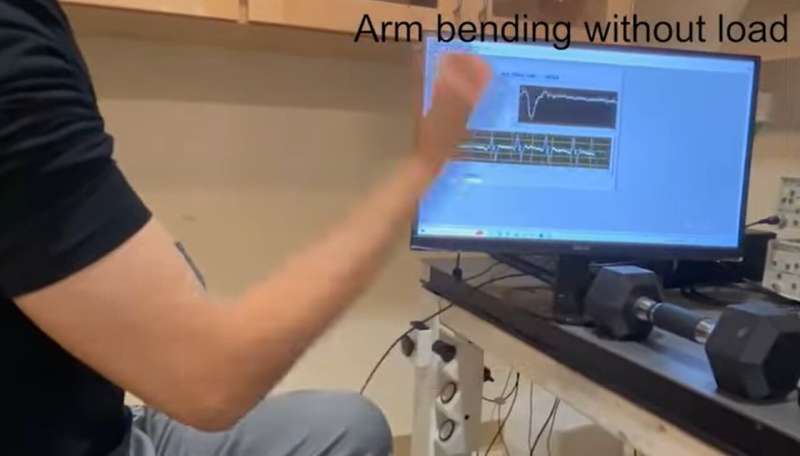This article has been reviewed according to Science X's editorial process and policies. Editors have highlighted the following attributes while ensuring the content's credibility:
fact-checked
peer-reviewed publication
trusted source
proofread
Patch uses nanomagnets to detect muscle movement through the skin

Using nanomagnets composites and conductive yarn, scientists have invented a smart textile that can sense and measure body movements—from muscles flexing to veins pulsing. The device, presented on June 27 in the journal Matter, is self-powered, stretchy, durable, waterproof, and can be made with a sewing machine for a few dollars. It may one day aid clinicians in assessing muscle injuries and support patients' recovery.
The smart textile is not technically made of fabric but has a cloth-like texture. It's made of a nanomagnet-filled rubber patch that is roughly the size of two stamps. Using a sewing machine, the researchers stitched silver-coated conductive yarn onto the patch in a coil design. Mechanical forces, such as a finger tap, can deform the pattern of magnetic fields within the rubber, thus creating an electric current through the yarn. The two phenomena where forces change magnetic fields and magnetic flux variations generate electricity are known as the magnetoelastic effect and electromagnetic induction.
"Our device is very sensitive to biomechanical pressure," says senior author Jun Chen of the Department of Engineering, University of California, Los Angeles. "The device converts muscle activities into quantifiable, high-fidelity electrical signals that are sent wirelessly to phone apps. This demonstrates the potential for personalized physical therapies and improving the rehabilitation of muscle injuries."
The device is not only sensitive, but it's also precise, detailing body movements down to each muscle group. Attaching the device to different body parts, researchers distinctly measured throat movements while drinking water, ankle movements while walking, and even monitored a person's pulse from their wrist. When affixed to a person's bicep, the device can show whether they are bending their arm or gripping their fist and to what degree or force. Based on these types of information, a clinician can find the Goldilocks zones to prevent over-excursion and encourage moderate activities, tailoring recovery goals for their patients.
Chen and his team also put the device's functionality to the test. To mimic real-world conditions such as excessive sweating and heavy rain the team wet the device with a water spray and tested its signal output. The signals remained strong. Besides being waterproof, the device is also stretchy and durable, extending 3.5 times its length and withstanding 100,000 cycles of deformation. From a production standpoint, Chen notes that the device is easy to fabricate and highly scalable, and each patch is estimated to cost less than $3.
"Another highlight of the device is its self-powering properties," says Chen. "The ability to convert biomechanical force to electricity means the device is also a generator. This eliminates the need for bulky, heavy, and rigid battery packs usually needed in wearable electronic designs."
Next, the team wants to make the smart textile thinner and lighter to optimize the wearer's experience. Chen and his team, who discovered the magnetoelastic effect in soft systems in 2021, also plan to explore new ways to incorporate his findings into other wearable or implantable bioelectronics.
"We've tested the device for cardiovascular monitoring and respiration monitoring as well," says Chen. "One day, we may be able to reinvent or replace current systems, such as EKGs, that require external power sources, and make them less bulky and more wearable."
More information: Jun Chen, A textile magnetoelastic patch for self-powered personalized muscle physiotherapy, Matter (2023). DOI: 10.1016/j.matt.2023.06.008. www.cell.com/matter/fulltext/S2590-2385(23)00294-1
Journal information: Matter
Provided by Cell Press





















